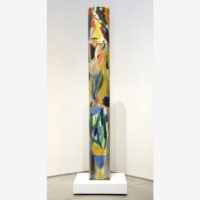ELAINE DE KOONING (1918-1989)
_27843.jpg)
_27843_detail1.jpg)
_27843_detail2.jpg)
_27843_detail3.jpg)
_27843_detail4.jpg)
_27843_detail5.jpg)
_27843_detail6.jpg)
_27843_detail7.jpg)
_27843_detail8.jpg)
_27843_detail9.jpg)
Provenance
Famille d'Elaine de KooningExposition
West Palm Beach, Floride, Ann Norton Sculpture Gardens, À la découverte de la créativité : maîtres de l’art américain, du 10 janvier au 17 mars 2024Histoire
Le brillant récit de Mary Gabriel sur les femmes qui se sont tenues à l'écart de leurs homologues masculins, puis qui les ont peints, devait bien s'arrêter à un moment donné. Après tout, Ninth Street Women fait 700 pages. Mais son dernier chapitre, intitulé à juste titre "Epilogue", résume la phase suivante de l'école de New York et de l'expressionnisme abstrait comme s'ils étaient morts en 1960, lorsque les toiles de Frank Stella, rigoureusement peintes en peinture noire, ont mis le monde de l'art sens dessus dessous. En vérité, il y avait plus qu'un changement de saison dans l'air de Manhattan, mais pour trois femmes - Joan Mitchell, Helen Frankenthaler et Elaine de Kooning - rien n'était plus faux. La plupart de leurs meilleurs travaux seront réalisés dans les décennies à venir. Quant à Elaine, en 1957, elle avait gagné une bataille acharnée pour parvenir à l'autosuffisance. Elle est libérée de Willem, possède sa propre voiture et, comme pour souligner ce fait accompli, elle voyage dans l'Ouest, découvre les couleurs et l'étendue du paysage et goûte au drame et aux couleurs de la corrida de la Plaza Monumental de Ciudad Juárez, au Mexique. Ses peintures et dessins ont été inspirés par la douzaine de corridas auxquelles elle a assisté. Ce sont des transmutations de cette expérience, des derviches tourbillonnants de couleurs et d'actions palpitantes. La ferveur avec laquelle elle attaquait la toile ou le support papier a changé à jamais. Soudain, voici une artiste qui se montre à la hauteur de l'idéal d'Harold Rosenberg lorsqu'il appelle la naissance de "l'action painting... une arène dans laquelle agir" et affirme que ce qui apparaît sur la toile "n'est pas une image mais un événement".
plus deLES CONNAISSANCES DU MARCHÉ
- Les deux prix les plus élevés pour des tableaux d'Elaine de Kooning vendus aux enchères viennent d'être fixés en mars 2021, ce qui témoigne de la valeur croissante des œuvres d'Elaine.
- "Red Bison/Blue Horse" des années 1980, a établi un nouveau record pour l'artiste lors de la vente aux enchères du 9 mars 2021, se vendant pour 562 500 USD.
- Une semaine plus tard, une peinture de corrida d'Elaine de Kooning datant de la fin des années 1950 a été vendue pour 428 400 USD, soit le deuxième prix le plus élevé pour l'artiste.
- Nous constatons que les œuvres d'artistes historiquement sous-évalués, comme Elaine de Kooning, continuent de prendre de la valeur.





























